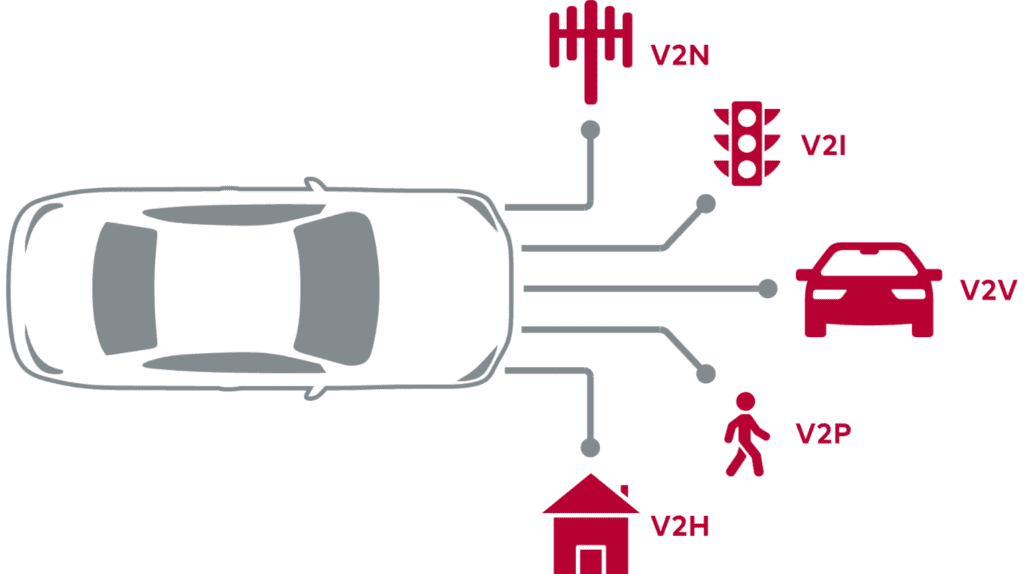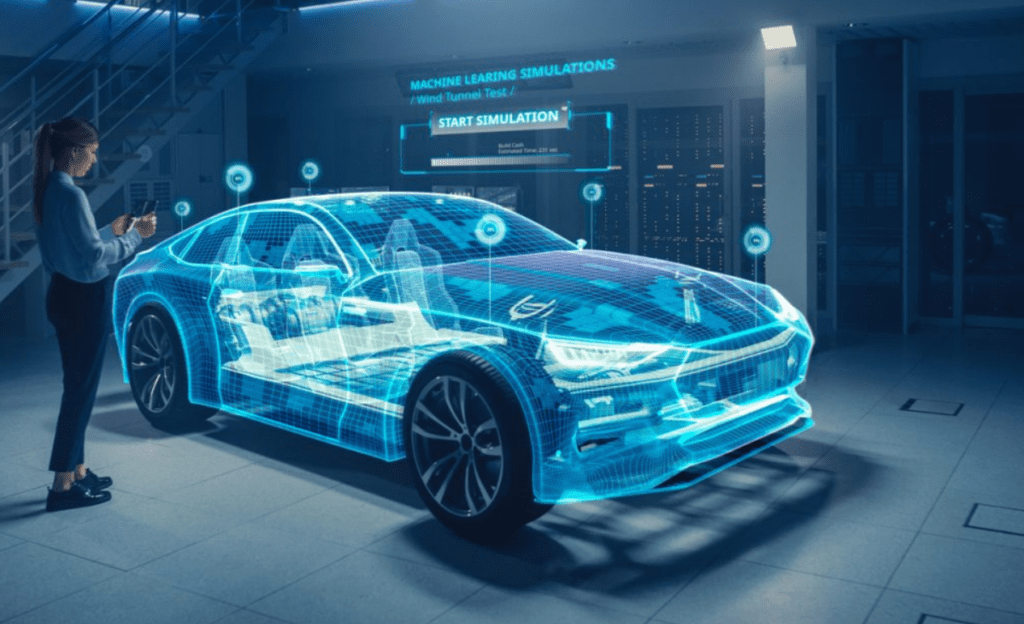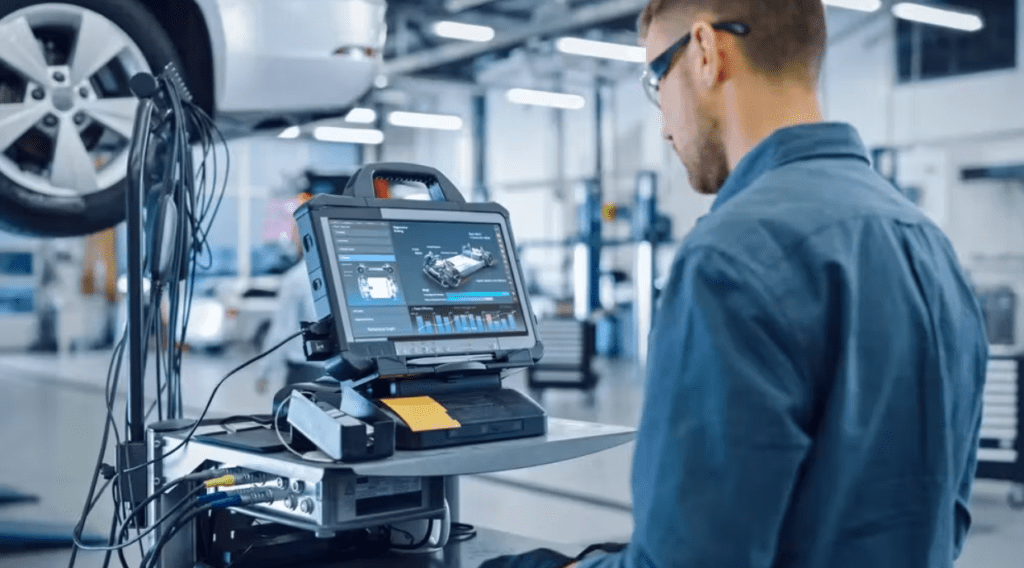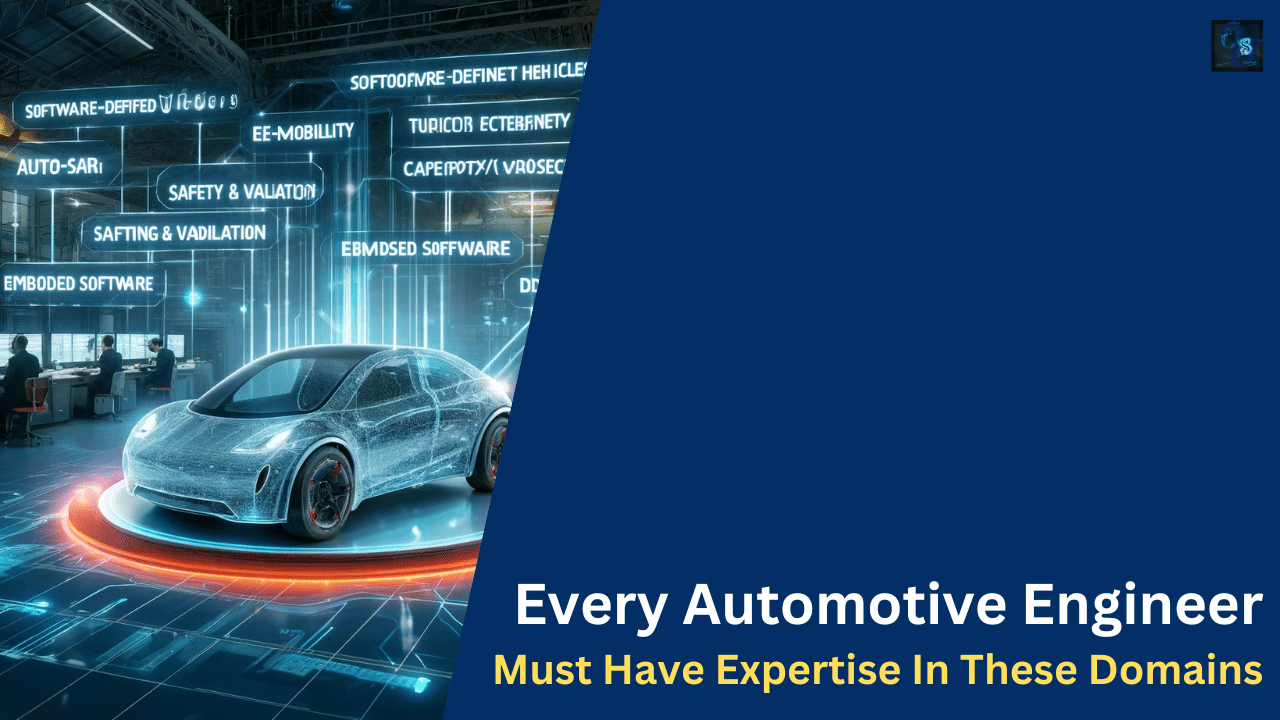Every Automotive Engineer Must Have Expertise In These Domains
Hello guys, welcome back to our blog. Here in this article, we will discuss automotive technologies that every automotive engineer must have expertise in to stay connected with the automotive industry.
Ask questions if you have any electrical, electronics, or computer science doubts. You can also catch me on Instagram – CS Electrical & Electronics
- Essential Tools For Embedded System Development And Testing
- Advantages Of Digital Twins In Automotive Manufacturing And Vehicle Development
- Cloud-Based HiL Testing: Benefits And Challenges
Every Automotive Engineer Must Have Expertise In These Domains
The automotive industry is undergoing a massive transformation driven by advancements in software, electrification, and connectivity. Traditional vehicle development, which primarily focused on mechanical engineering, is now shifting towards a software-centric approach. Engineers are required to adapt to new technologies and methodologies to stay relevant in the evolving landscape.
To thrive in the automotive sector, engineers must develop expertise in key domains such as Software-Defined Vehicles (SDVs), AUTOSAR, E-Mobility, Automotive Ethernet, Testing & Validation, Safety & Cybersecurity, Connectivity (Car-to-X/V2X), Virtualization, Diagnostics, Embedded Software, and Software Factories. Mastery of these areas ensures engineers are well-equipped to handle modern automotive challenges.
01. Software-Defined Vehicles (SDVs)

Software-defined vehicles represent a shift from traditional mechanical vehicles to digital platforms where software dictates vehicle functions. SDVs enable real-time updates, improved performance, and enhanced connectivity, making vehicles more efficient and intelligent.
Key aspects of SDVs:
- Separation of hardware and software for flexibility.
- Over-the-air (OTA) updates for continuous improvements.
- Cloud-based vehicle management and data processing.
- Integration of AI and machine learning for autonomous features.
- Enhanced user experience through personalized software solutions.
02. AUTOSAR & Adaptive AUTOSAR

AUTOSAR (Automotive Open System Architecture) provides standardized software architecture for automotive ECUs, improving interoperability, scalability, and efficiency. Adaptive AUTOSAR extends these capabilities to support connected and autonomous vehicles.
Key aspects of AUTOSAR & Adaptive AUTOSAR:
- Standardized software interfaces for modular development.
- Classic AUTOSAR for real-time control systems.
- Adaptive AUTOSAR for high-performance computing applications.
- Enhanced cybersecurity and safety features.
- Support for cloud-based and edge computing solutions.
03. E-Mobility

The shift towards electrification is revolutionizing the automotive industry. Engineers must understand battery technologies, power electronics, and energy management to develop efficient electric vehicles (EVs).
Key aspects of E-Mobility:
- Battery Management Systems (BMS) for optimal performance.
- Fast-charging and thermal management solutions.
- Regenerative braking and energy recovery systems.
- Integration of renewable energy sources for sustainable mobility.
- Advances in solid-state battery and hydrogen fuel cell technology.
04. Automotive Ethernet

As vehicle networks become more complex, traditional communication protocols like CAN and LIN are being supplemented by high-speed Automotive Ethernet. This technology enhances data transfer efficiency and enables advanced connectivity features.
Key aspects of Automotive Ethernet:
- High-bandwidth communication for ADAS and infotainment.
- Reduced wiring complexity and weight.
- Real-time data exchange for vehicle-to-everything (V2X) communication.
- Secure and scalable network architecture.
- Compliance with automotive communication standards such as IEEE 802.1.
05. Testing & Validation

Ensuring vehicle safety and performance requires rigorous testing and validation. Engineers must be skilled in various simulation and testing methodologies to detect and rectify potential issues before deployment.
Key aspects of Testing & Validation:
- Model-in-the-Loop (MiL) and Software-in-the-Loop (SiL) simulations.
- Hardware-in-the-Loop (HiL) testing for real-world scenarios.
- Automated test environments for efficiency and accuracy.
- Compliance with international safety and performance standards.
- Continuous integration and validation in agile development.
06. Safety & Cybersecurity

With the increasing digitalization of vehicles, safety, and cybersecurity have become critical concerns. Engineers must design secure architectures that protect vehicles from cyber threats and ensure functional safety.
Key aspects of Safety & Cybersecurity:
- ISO 26262 compliance for functional safety.
- ISO/SAE 21434 standards for automotive cybersecurity.
- Secure communication protocols to prevent hacking.
- Intrusion detection and prevention systems.
- Risk assessment and vulnerability mitigation strategies.
07. Connectivity – Car-to-X (C2X) & Vehicle-to-Everything (V2X)

Connected vehicles rely on advanced communication systems to interact with their environment, improving traffic efficiency and safety. Engineers must understand these connectivity technologies to develop smart mobility solutions.
Key aspects of Connectivity:
- Vehicle-to-Vehicle (V2V) and Vehicle-to-Infrastructure (V2I) communication.
- 5G and edge computing for real-time data exchange.
- Traffic management and congestion control applications.
- Enhanced driver assistance systems through AI integration.
- Cybersecurity challenges and solutions in connected vehicles.
08. Virtualization in Automotive

Virtualization enables efficient software deployment and management by separating hardware resources into virtual environments. It plays a crucial role in software-defined vehicle architectures and ECU consolidation.
Key aspects of Virtualization:
- Hypervisors for running multiple operating systems.
- ECU consolidation to reduce hardware complexity.
- Secure execution environments for critical applications.
- Cost-efficient software updates and management.
- Support for cloud-based automotive functions.
09. Automotive Diagnostics

Automotive diagnostics play a crucial role in vehicle maintenance, fault detection, and performance optimization. Engineers must understand various diagnostic protocols and techniques.
Key aspects of Automotive Diagnostics:
- On-board diagnostics (OBD-II) for real-time fault monitoring.
- Unified Diagnostic Services (UDS) for advanced troubleshooting.
- Remote diagnostics and predictive maintenance.
- Integration of AI and data analytics for fault prediction.
- Compliance with industry standards like ISO 14229.
10. Embedded Software Development

Embedded software forms the backbone of modern automotive systems, controlling everything from infotainment to powertrain functions. Engineers must develop expertise in embedded system design and programming.
Key aspects of Embedded Software Development:
- Real-time operating systems (RTOS) for automotive control units.
- Programming languages such as C, C++, and Python.
- Middleware solutions for seamless communication.
- AI and machine learning integration in embedded systems.
- Efficient resource management for optimal performance.
11. Software Factory in the Automotive Industry

The concept of a software factory streamlines automotive software development by adopting DevOps and agile methodologies. This ensures faster, more efficient, and scalable software production.
Key aspects of Software Factory:
- Agile and DevOps practices for iterative development.
- Continuous Integration & Continuous Deployment (CI/CD).
- Automated testing and verification pipelines.
- Cloud-based software development environments.
- Efficient collaboration between hardware and software teams.
Conclusion
The automotive industry is shifting towards a software-driven future, requiring engineers to expand their skill sets in multiple domains. From SDVs and AUTOSAR to cybersecurity and diagnostics, mastering these fields ensures engineers stay relevant and contribute to the future of mobility. By continuously learning and adapting, automotive engineers can play a crucial role in shaping the next generation of intelligent, connected, and sustainable vehicles.
This was about “Every Automotive Engineer Must Have Expertise In These Domains“. Thank you for reading.
Also, read:
- 100 (AI) Artificial Intelligence Applications In The Automotive Industry
- 2024 Is About To End, Let’s Recall Electric Vehicles Launched In 2024
- 50 Advanced Level Interview Questions On CAPL Scripting
- 7 Ways EV Batteries Stay Safe From Thermal Runaway
- 8 Reasons Why EVs Can’t Fully Replace ICE Vehicles in India
- A Complete Guide To FlexRay Automotive Protocol
- Adaptive AUTOSAR Vs Classic AUTOSAR: Which One For Future Vehicles?
- Advanced Driver Assistance Systems (ADAS): How To Become An Expert In This Growing Field

